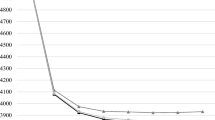Abstract
We used delayed multiple-baseline and multiple-probe techniques to assess the effects of self-evaluation training on the legibility of cursive handwriting. Five secondary special education students with difficult-to-read handwriting served as participants. All participants improved the legibility of their handwriting during self-evaluation training. A systematic withdrawal of the training package demonstrated maintenance of treatment effects. For the most part, the students' handwriting remained at least 90% legible to judges following the systematic withdrawal of the self-evaluation training.
Similar content being viewed by others
References
Askov, E., Otto, W., & Askov, W. (1970). A decade of research in handwriting.Journal of Educational Research, 64, 100–112.
Azrin, N. H. (1977). A strategy for applied research: learning based but outcome oriented.American Psychologist, 32, 149–159.
Baer, D. M., & Fowler, S. A. (1984). How should we measure the potential for self-control procedures for generalized educational outcomes? In W. L. Heward, T. E. Heron, D. S. Hill, & J. Trap-Porter (Eds.),Focus on behavior analysis in education (pp. 145–162). Columbus, OH: Merrill Publishing Company.
Bergman, K. E., & McLaughlin, T. F. (1988). Remediating handwriting difficulties with learning disabled students: A review.British Columbia Journal of Special Education, 12, 101–120.
Burgio, L. D., Whitman, T. L., & Johnson, J. A. (1980). A self-instructional package for increasing attending behavior in educable mentally retarded children.Journal of Applied Behavior Analysis, 13, 443–459.
Duval, B. (1985).Evaluation of eleventh grade students' writing supports teaching italic handwriting. (ERIC Document Reproduction Services No. ED 263 608)
Giordano, G. (1982). CATS exercises: Teaching disabled writers to communicate.Academic Therapy, 18, 233–237.
Heward, W. L. (1978).The delayed multiple-baseline design. Paper presented at the Fourth Annual Convention of the Association for Behavior Analysis, Chicago.
Heward, W. L., Heron, T. E., Gardner, R., & Prayzer, R. (1991). Two strategies for improving students' writing skills. In G. Stoner, M. R. Shinn, & H. M. Walker (Eds.),Interventions for achievement and behavior problems (pp. 379–398). Silver Spring, MD: National Association of School Psychologists.
Horner, R. D., & Baer, D. M. (1978). Multiple-probe technique: A variation of the multiple-baseline.Journal of Applied Behavior Analysis, 11, 189–196.
Johns, J. C., Trap, J., & Cooper, J. O. (1977). Technical report: Students' self-recording of manuscript letter strokes.Journal of Applied Behavior Analysis, 10, 509–514.
Kosiewicz, M. M., Hallahan, D. P., Lloyd, J., & Graves, A. W. (1982). Effects of self-instruction and self-correction procedures on handwriting performance.Learning Disabilities Quarterly, 5, 71–78.
Manning, M. L. (1986). Responding to renewed emphasis on handwriting.Clearinghouse, 59, 211–213.
McLaughlin, T. F., Mabee, W. S., Byram, B. J., & Reiter, S. M. (1987). Effects of academic positive practice and response cost on writing legibility of behaviorally disordered and learning-disabled junior high school students.Journal of Child and Adolescent Psychotherapy, 4(3), 216–221.
Mercer, C. D., & Mercer, A. R. (1989).Teaching students with learning problems (3rd ed.). Columbus, OH: Merrill.
Miller, A. D., Hall, S. W., & Heward, W. L. (1991).Effects of sequential 1-minute time trials, with and without inter-trial feedback, on regular and special education students' fluency with math facts. Unpublished manuscript, The Ohio State University, Department of Educational Services and Research, Columbus.
Nelli, E. (1982). Penmanship: Neglected tool in teacher preparation.Teacher-Educator, 18, 26–32.
Okyere, B. A., & Heron, T. E. (1991). Use of self-correction to improve spelling in regular education classrooms. In G. Stoner, M. R. Shinn, & H. M. Walker (Eds.),Interventions for achievement and behavior problems (pp. 399–413). Silver Spring, MD: National Association of School Psychologists.
Peck, M., Askov, E., & Fairchild, S. (1980). Another decade of research in handwriting: Progress and prospects.Journal of Educational Research, 73, 283–298.
Ruedy, L. R. (1983). Handwriting instruction: It can be part of the high school curriculum.Academic 20 Therapy, 18, 421–429.
Rusch, F. R., & Kazdin, A. E. (1981). Toward a methodology of withdrawal designs for assessment of response maintenance.Journal of Applied Behavior Analysis, 14, 131–140.
Sainato, D. M., Strain, P. S., Lefebvre, D., & Rapp, N. (1990). Effects of self-evaluation on the independent work skills of preschool children with disabilities.Exceptional Children, 56, 540–549.
Samuels, S. J. (1979). The method of repeated readings. Reading Teacher, 32, 403–408.
Scott, J., Stoutimore, J., Wolking, W., & Harris, C. (1990). Challenging reading: For students with mild handicaps.Teaching Exceptional Children, 22, 32–35.
Sindelar, P. T., & Stoddard, K. (1991). Teaching reading to mildly disabled students in regular classes. In G. Stoner, M. R. Shinn, & H. M. Walker (Eds.),Interventions for achievement and behavior problems (pp. 333–355). Silver Spring, MD: National Association of School Psychologists.
Stokes, T. F., & Baer, D. M. (1977). An implicit technology of generalization.Journal of Applied Behavior Analysis, 10, 349–367.
Stowitschek, J. J., Ghezzi, P. M., & Safely, K. N. (1987). “I'd rather do it myself:” Self-evaluation and correction of handwriting.Education and Treatment of Children, 10, 209–224.
Sweeney, W. J., Omness, C. K., Janusz, K. L., & Cooper, J. O. (1992). Adult literacy and Precision Teaching: Repeated readings and see/cover/write practice to improve reading and spelling.The Journal of Precision Teaching, 9, 6–19.
Talbert-Johnson, C., Salva, E., Sweeney, W. J., & Cooper, J. O. (1991). Cursive handwriting: Function rather than topography.Journal of Educational Research, 85, 117–124.
Author information
Authors and Affiliations
Rights and permissions
About this article
Cite this article
Sweeney, W.J., Salva, E., Cooper, J.O. et al. Using self-evaluation to improve difficult-to-read handwriting of secondary students. J Behav Educ 3, 427–443 (1993). https://doi.org/10.1007/BF00961545
Accepted:
Issue Date:
DOI: https://doi.org/10.1007/BF00961545




